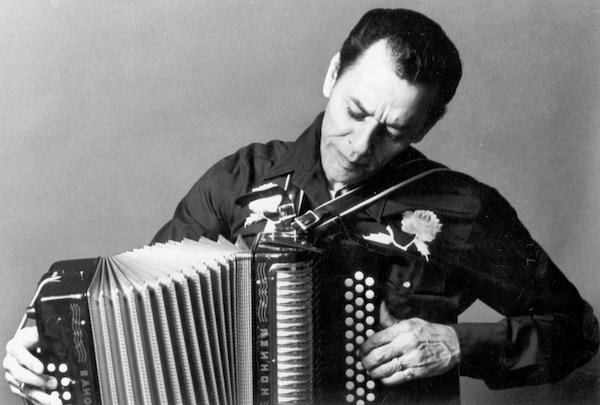Santiago Jiménez, Jr.

Photo by Jane Levine
Bio
Texas-Mexican conjunto music is an original American creation. In the late 19th century, German, Polish, and Czech immigrants settled in the predominantly Mexican region of the Texan Rio Grande valley, bringing with them popular forms of dance music such as the polka, waltz, schottische, mazurka, and redowa. These international social dance vogues had already been introduced into Mexican society on both sides of the border. Their deep rootedness in the large immigrant communities, however, gave these music and dance forms greater prominence -- and permanence -- in southern Texas and in neighboring northern Mexico. Along with the dancing came a certain musical instrument that had swept across Europe and beyond since its invention earlier in the century -- the diatonic button accordion. Tejanos -- Texans of Mexican descent--quickly adopted this raucous instrument as their own, and, over time, they built around it a musical group that would come to be strongly identified with their regional culture. This group is called simply the conjunto -- literally, combo, or ensemble.
Santiago Jiménez, Jr., born in 1944, was heir to a rich family tradition of button accordion playing. His grandfather Patricio Jiménez played the accordion, and he would take his son Santiago to hear German polka bands in New Braunfels. Santiago, Sr. became one of the seminal figures in the rise of the conjunto, being one of the first accordionists to add the string bass (tololoche), make phonograph recordings, and appear on the radio in the 1930s. Santiago, Jr.'s brother, Leonardo "Flaco" Jiménez, through his success in performing with country and western stars and popular music crossover groups, has become one of the most widely known Tejano accordionists.
Santiago Jiménez, Jr. has long preferred to model himself more closely on his father's lively melodic style, a style that is identified with the roots of the tradition. Also in this spirit, he continues to use the acoustic tololoche, as opposed to the electric bass typical of most contemporary conjuntos, and he rarely incorporates the drum set as do most Texan conjuntos. At age fifteen, he began performing professionally at weddings, clubs, and quinceañeras ("debutante" celebrations for fifteen-year-old girls), traditional community settings for conjunto music. While closely following his father's example, he has taken the tradition both forward in terms of creativity, and outward in terms of the wide audiences he has reached. He made his first recording in 1958 at the age of seventeen, with his brother Flaco, entitled El Pr’ncipe y el Rey del Acordeón (The Prince and the King of the Accordion). Since then, he has made over sixty other recordings of more than 700 pieces on regional labels such as Disco Grande, Disco Sombrero, and Disco Corona, and on the national labels Arhoolie, Rounder, and Watermelon. He also started his own record label, Chief Records (many friends call him by the nickname "Chief"), giving younger musicians the opportunity to let their music be heard. In recent decades, Santiago Jiménez has toured widely throughout the United States and to Europe and the Americas -- including Russia, Great Britain, Spain, France, and Mexico. In the contemporary world of Tejano music, Santiago Jiménez, Jr. is seen as a standard bearer of deep conjunto tradition, a lively performer, and a man of great humor and wit.

